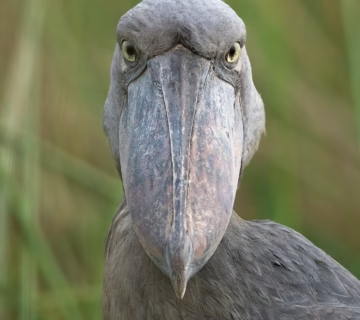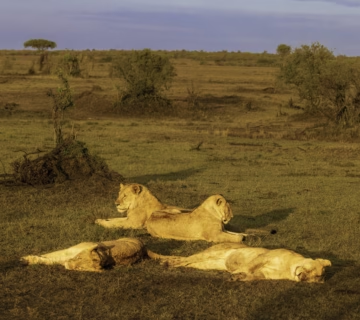Bwindi Impenetrable National Park
Typical tropical rain forest, Bwindi Impenetrable National Park (Bwindi Forest National Park) has an annual mean temperature range of minimum of 7–15°C to high of 20–27°C. Its yearly precipitation falls between 1,400 and 1,900 millimeters. From March to April and from September to November, the severe rains peak.
Gorilla hiking helped the Bwindi Impenetrable forest become well-known worldwide. More over half of the surviving Mountain Gorilla population in the world calls home here. The forest has more than 360 individuals of the estimated 800 plus mountain gorillas worldwide, and these gentle monkeys are extremely rare species.
Diseases, habitat degradation, and poaching have greatly threatened them. Among all the safari parks in Uganda, this national park brings one of the biggest earnings for Uganda Wildlife Authority.
On the brink of the rift valley in the southwest, Bwindi Often referred to as the impenetrable forest, Bwindi Impenetrable National Park is surrounded on the western side by the Democratic Republic of Congo (DRC); 29 kilometers distant by road, Kabale town lies southeast of the park.
Covering an area of 331 square kilometers, it is situated in the highest sections of Kigezi highlands with a height ranging from 1,190 to 2,607 meters above sea level. Of 60% of this wonderful park, their elevation exceeds 2,000 meters above sea level. The lowest point of the park is found at its most northern extremity; Rwamunyonyi hill at the eastern side stands as the highest elevation point.
By car, Bwindi Forest National Park is about an 8- or 9-hour journey from Entebbe; by chartered aircraft, it is about one hour distant. Usually, the first and last days of Uganda gorilla trips are set aside just for travel and a few other minor excursions along the route.
Although the trip is very long, especially if you are driving, it is absolutely worth it if you come across a close encounter with the mountain gorillas in their habitat. Though this location seems among the most frequented Uganda safari parks, there is actually a lot behind it that you will definitely notice when you arrive.
Please review the list of suggested gorilla safari operators who may arrange for unique safari trips in the remoteness of Bwindi Impenetrable National Park. Also below are some of our most often used safari packages;
Bwindi Impenetrable National Park Safari Activities
Gorillas Trekking
Under Gorilla Trekking, a group of individuals may travel or trek into the deep forests to obtain a peek of what gorillas look like and be able to see the surroundings where they live.
Currently including six gorilla trekking areas—Buhoma, Nkuringo, Ruhija, Rushaga, Nyundo and Rubugiri—Bwindi forest national park boasts Buhoma and Nkuringo as among the most popular sectors.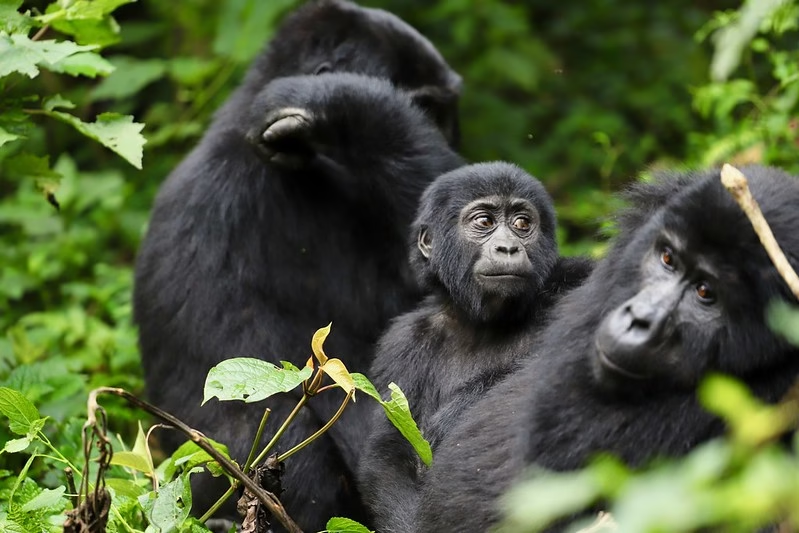
Long making it feasible for visitors to combine Uganda gorilla trekking experiences with Rwanda gorilla trekking in a single itinerary is the proximity of the national park to the Rwandan border. Depending on a client’s inclination, such visits can start either way, allowing Gorilla Trekking in Bwindi from Rwanda – around (4 – 5 hours driving) from Kigali.
When should one go gorilla trekking in Uganda?
Mid-June through October, December extending into March is the ideal period to see the mountain Gorillas in Uganda. Right now is the busiest and finest time of year. These are dry months of the year, the peak seasons for Gorilla Trekking. Mountain Gorillas may be visited all year long in Uganda without seasonal closures.
Gorilla Habituation
Gorilla habituation is the experience of seeing the mountain gorillas for more than the normal hours as these gorillas are being taught to live among humans. Because it allows the visitor more time to learn about the mountain gorillas and their actions, the trip is rather interesting.
Only in Rushaga gorilla sector, south of Bwindi impenetrable forest national park, does gorilla habituation occur in Uganda.
Gorilla habituation in Uganda best takes place between June through September and December through March.
Birding
Over 320 bird species and 23 species call Bwindi National Park home. The bird species include Western Green Tinker bird, African Wood Owl, Archer’s Robin-Chat, Red-throated Alethe, Fine-banded Woodpecker, Grauer’s Rush Warbler, Handsome Francolin, Chestnut-throated Apalis, Regal Sunbird, Collared Apalis, Montana Oriole, and Short tailed Warbler, 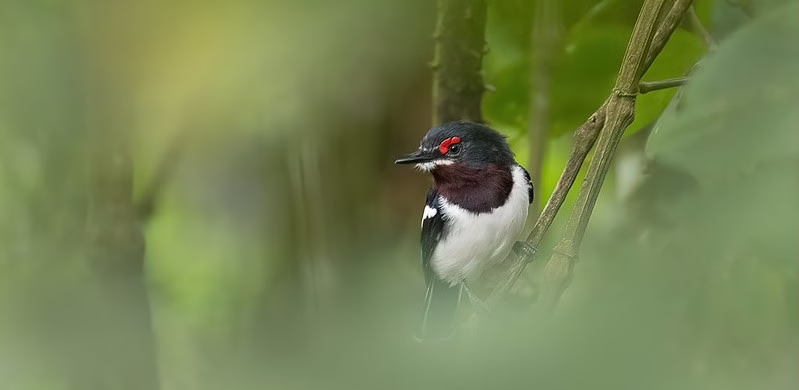 Kivu Ground-Thrush, Chapin’s Flycatcher and African Green Broadbill and Green-breasted Pitta, African Green Broadbill, Great Blue Turaco Shelley’s Crimsonwing, Standard-winged Nightjar, flycatcher, Short-tailed Warbler, Doherty’s Bush shrike, Bar-tailed Trogon, Black-breasted Barbet and many more.
Kivu Ground-Thrush, Chapin’s Flycatcher and African Green Broadbill and Green-breasted Pitta, African Green Broadbill, Great Blue Turaco Shelley’s Crimsonwing, Standard-winged Nightjar, flycatcher, Short-tailed Warbler, Doherty’s Bush shrike, Bar-tailed Trogon, Black-breasted Barbet and many more.
Gorilla Trekking Sectors
Four gorilla trekking sectors—Buhoma, Rushaga, Ruhija, Nkuringo and Mugahinga—which was just added—are found in Bwindi impenetrable national park. Actually the only area allowed for Gorilla Habituation in Bwindi National Park, Rushaga has five gorilla families. One should be ready for the experience as visiting Uganda and the Bwindi national park would be mind-blowing.
Approaching Bwindi
About 478 kilometers from the capital city, Kampala, Bwindi Forest National Park Uganda may be driven in seven to eight hours. Mostly on a smooth surface, the route is dirt murram for the last stretch into the forest. From Queen Elizabeth National Park, one may also visit Bwindi National Park by driving three to four hours over the Ishasha area.
From Kampala to Kabale, Kisoro, and Rukungiri via Kihihi daily buses run. From such villages, you may arrange with a local guide to be picked up or just link to Bwindi National Park. Flying from Entebbe airport to Kihihi or Kisoro airstrip on a domestic aircraft allows one to also reach the park by air.
Aero Link is a local operator running daily flights to Bwindi’s Kihihi airstriks from Kisoro (only in the morning).
The flight timetables and timings are below;
From To depart arrive.
Entebbe Kings 07:45 AM 08:55 AM
Kisoro entebbe 09:10 AM 11:25 AM
Entebbe Kihihi 07:00 AM 08:45 AM
Kihihi entebbe 09:45 AM 11:25 AM
Entebbe Kihihi 01:55PM 12:45 PM
Kihihi entebbe 12:45 PM 03:55 PM
Those who would like to visit Buhoma might board charter flights at the Kayonza airfield.
Gorilla families
Gorillas in Bwindi Impenetrable National Park are arranged in gorilla families with designated habitat. Usually, the gorilla families have a silverback as the male and the one running the household. Trekkers follow gorilla families and where they are found (Gorilla Sector). We have a whole list of gorilla families found in Bwindi Impenetrable National Park here.
Attractions inside Bwindi Impenetrable National Park
Given that the Bwindi impenetrable national park features several appealing tourist attractions, it is among the most visited national parks worldwide.
Bwindi impenetrable national park’s tourist attractions include in:
Mountain Gorillas
The main draw of Bwindi Impenetrable National area is mountain gorilla; estimates of the 400 or more mountain gorilla individuals living in the area span several different sections of the park. Mountain gorillas dwell in these areas of the park; thus, these areas also have diverse interesting gorilla families.
BUHOMA SECTOR
Located in the northern part of Bwindi Impenetrable National Park, Buhoma sector is the most interesting and frequented sector in the park; it is the first one to be opened for trekking with the mubare gorilla family for visitors. First family to settle in the buhoma area of Bwindi impenetrable national park is the Mubare gorilla family, having arrived in 1992.
There three gorilla families in the Buhoma sector:
Family of Mubare Gorators
First habituated in 1992, the Mubare gorilla family is the first to be available for gorilla trekking. Currently consisting of five members, this family is named for the mubare highlands from whence this group was initially seen. Kanyonyi a dominant silverback leads the Mubare gorilla family with one adult female, two sub-adult females, and one youngster.
Families of Habinyanja gorillas
Originally from a Rukinga term Nyaja, meaning a location with water, the Habinyanja gorilla family was initially seen close to marsh ponds of Bwindi impenetrable national park. They were habituated in 1997 and first hiked in 1999. Makara, Rwansigazi, Maraya, Kisho, Nabukye, Binyonko, Rugyendi, Nyamuhango, Elsa, Hamusini, Hakato, Gacyaro and Bangenyi are the 13 notable members of the Habinyanja gorilla family. Makara a powerful silverback is the family leader.
Family of Rushegura Gorillas
Rushegura gorilla family split from Habinyanja gorilla family in 2000 and offered for trekking in the same year.
Since the southern portion of Queen Elizabeth national park is near ishasha sector, the Buhoma sector is quite accessible by routes from kabala, utilizing kihihi airstrip and from Queen Elizabeth national park.
NKURINGO SECTOR
Only three gorilla families reside in the southern section of Bwindi impenetrable national park Kisoro district; Nkuringo sector is home to these families.
gorilla family nkuringo
Initiated in 1997, the Nkuringo gorilla family is the first group of gorillas living in the southwest of Bwindi. Twelve gorilla members make up the Nkuringo gorilla family: one silverback, two adult females, two sub-adult females, three youngsters, two newborns. Originally consisting of 17 family members, the Nkuringo gorilla family is historical as it is the first family in Bwindi impenetrable national park to document the birth of twins. Many members departed the park and only left 12 in this family group.
Family of bikingi gorillas
Originally habituated as early as 2012, the amazing Bikingi gorilla family is unique for gorilla habituation experience. There are now fifteen family members in this family: one silverback, five adult females, two sub-adults, two young ones and five newborns. As the Bikigi gorilla family is still going through habituation, its leader is not yet known.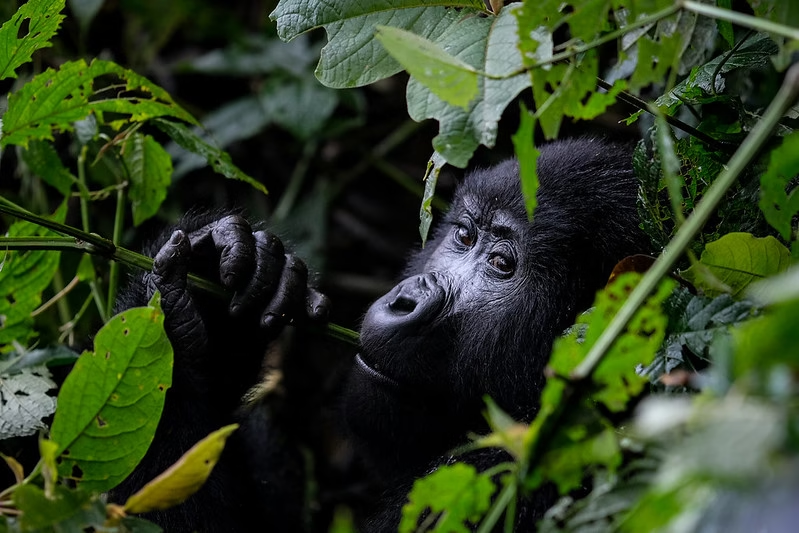
Bushho Gorilla Family
Comprising eight members including one silverback, one blackback, three adult females, one sub-adult, one young juvenile, and one newborn, Bushaho gorilla family is Many members of Nkuringo gorilla family broke off to create Bushaho gorilla family; this family is led by a powerful silverback Bahati.
National parks Virunga and Bwindi Impenetrable Forest
National parks in Virunga and Bwindi Impenetrable Forest
SECTOR RUSHAGA
Situated in the southern part of the park, the Rushaga sector is the most frequented one in Bwindi impenetrable national park with visitors arriving from Kigali by cyanika border in Kisoro district. Mountain gorilla families in the Rushaga area of the park have the highest number in the park and comprise
Nshongi family of gorillas
Comprising seven family members under the direction of Bweza, a strong silverback, Nshongi gorilla family is an interesting group found in Bwindi Impenetrable National Park. One silverback, one young female, one newborn, three adult females, one subadult total.
The family Kahungye gorilla
Under the leadership of a dominating silverback Rumaz, Kahungye gorilla family consists of 17 individuals derived from kahungye hill where these gorilla were first observed in this area. Three adult females, three silverbacks, two newborns, three adolescents, and three sub adults make up this family.
family of busingye gorillas
Under the direction of dominant silverback Busingye, the nine members of the Busingye gorilla family split away from their original family. This group takes its name from a native phrase that denotes peace.
family of Mishaya gorillas
Originally founded in 2010 by Mishaya who broke away from Nshongi gorilla group, the 12 members of the Mishaya gorilla family are led by a dominating silverback Mishaya.
The family Bweza Gorilla
Under the leadership of a silverback under the titles kakono, the 23 mountain gorilla family known as Bweza gorilla consists of 2 silverbacks, 4 black backs, 1 sub-adult, 3 adult females, and 2 newborns.
RUHija Sector
Ruhija sector is located in the eastern part of Bwindi impenetrable national park; it is an incredible sector with three gorilla families where mountain gorilla trekking takes place. Among these families include
Family bitukura gorilla
Comprising four silverbacks, four adult families, two young adults, three babies, and one newborn, Bitukura gorilla family is fourteen family members. Originally consisting of 24 family members, this family was settled in 2007 and lately the group had ongoing strife that drove several members to flee from the group.
The Oruzogo gorilla family
The family Kyaguliro gorilla
The Kyaguliro gorilla family is quite large, consisting of twenty family members; this family was set aside for study purposes, hence it is not often seen. Kyaguliro A and Kyaguliro B split off the organization following the death of its then leader, who was struck dead by lightening.
Under the direction of Rukara a dominating silverback, Kyaguliro A– comprises of 10 family members: 1 silverback, 2 black backs, 3 adult females, 2 young adults, 2 newborns.
Under the direction of Mukiza a dominant silverback, Kyaguliro B– comprises of 10 family members—one silverback, four adult females, one adult and four newborn.
Mammals and other primates
Although mountain gorillas are well-known to call Bwindi impenetrable national park home, the park also hosts incredible mammals including forest elephants, giant forest hog, antelopes, side stripped jackal, African civet, and many more in the deep forests of the park.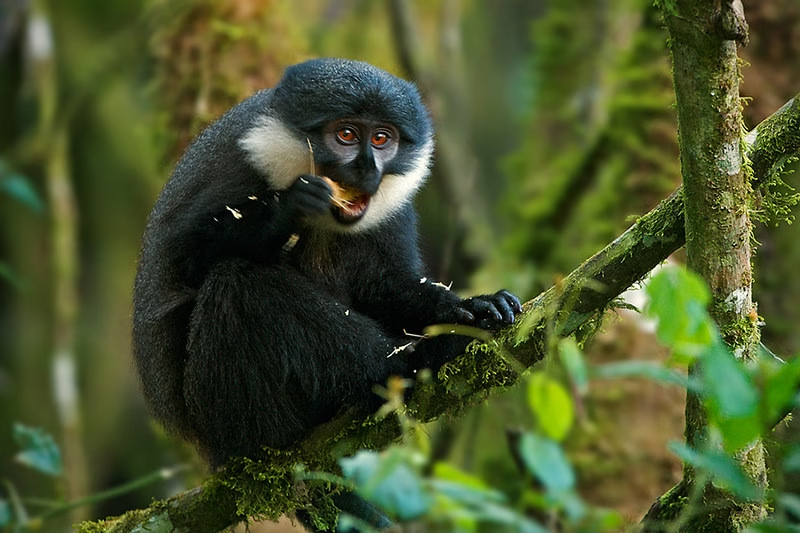
Other primates that call Bwindi impenetrable national park home are chimpanzees, black and white colobus monkeys, vervet, L’hoest, De Brazza, red tailed monkey, nocturnal potto and galago species.
old rainforest
On a record Bwindi impenetrable national park, one of the few places in Africa covered by tropical forest as lowland and montane vegetation zones converge here. Bwindi impenetrable national park is a huge biological system covered in many types of flora. Renowned water catchment region Bwindi impenetrable national park is traversed by several minor rivers like Ivi, Munyaga, ihihizo, ishasha and ntengyre which discharge their waters in Lake Edward. Conopy of plant species include Red stinkwood, Newtonia, Symphonia globulifera, East African yellow wood and Strombosia scheffleri define the park. Under the main forest lie species like Xymalos, Neoboutonia Macrocalyx, Monospora, Myrianthus holstii, Teclea nobilis and Allophylus abyssinicus.
With a reported 220 tree species and 100 fern species, afro montane forests—a unique plant type on the African continent—cover Bwindi impenetrable national park.
Hiking paths
Another well-known feature in Bwindi Impenetrable National Park are hiking paths that go to various areas of the park and attractions. Using these paths will allow you to come upon many park secrets. These paths are utilized for hiking and ecological walks throughout the park and comprise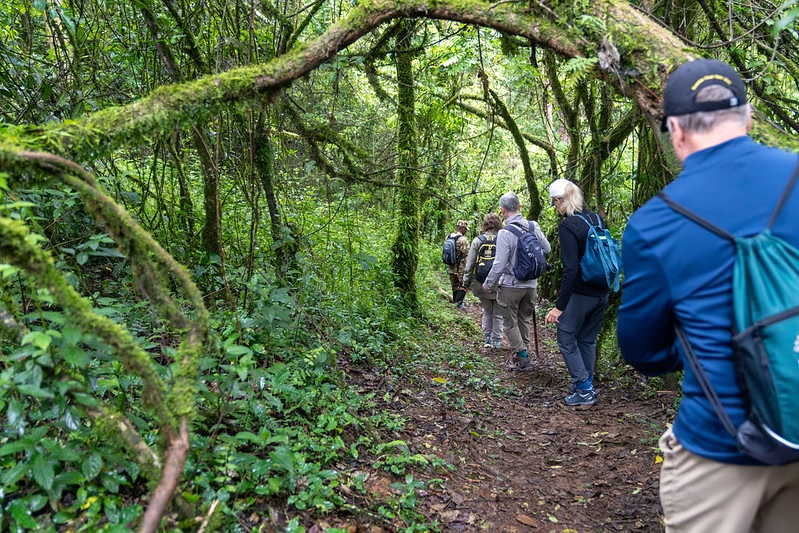
Hiking on the River Ivi trail—which is the greatest bird viewing path throughout Nkuringo—it takes seven hours to complete and covers fourteen kilometers.
Hiking a 4-hour trek going to the waterfall in the park starts Waterfall trek.
Most visitors utilize the 4–6 hour Habinyanja path, which passes past river Munyanga. This trail is used by trekking Habinyanja gorilla family.
Running between Nkuringo and buhoma sections of the Bwindi impenetrable national park, the 5-7 hour Kashasha river path is for treking.
Six hours of a beautiful track up to Rwamunyonyi summit is bamboo trail. For bird observation, bamboo trail is the finest one.
Muzabajiro hike: Muzabajiro is a 6-kilometer walk with breathtaking views of western rift valley and Virunga. While on it you come across lovely ferns, a range of bird species, and summit of Virunga mountains.
Avines
Bwindi impenetrable national park is ideal for montane-forest bird viewing in Africa as it supports a range of bird species most specifically water and forest bird species. Over 350 bird species call Bwindi impenetrable national park home; of these species, 14 are indigenous to the park and 23 are only found in Albertine Rift.
Buhoma waterfall trail, Mubwindi swamp trail, and bamboo zone are the most fantastic paths for bird viewing in Bwindi impenetrable national park.
Pygmy Batwa people
Originally living in the Bwindi woods, the Batwa pygmy people were forcibly expelled from the forest to the periphery of the protected region known as the Batwa pygmy range.
Hunter-gathers who mostly rely on hunting wild animals and collecting fruits, the Batwa people seen as the stewards of the forest nonetheless lead archaic lives. When visiting Bwindi impenetrable national park, you will meet the Batwa people for a cultural encounter where you will come across these incredible people continuing their daily lives in an old manner.
You will see people making homes with locally sourced materials, hunting tiny animals, local dance and theater, many of which will astound you.
Why does Bwindi Forest National Park appeal to you?
The name of “Bwindi” should set off loads of ideas in one’s head. Just a forest tucked away in southern western Uganda, Bwindi is split by the districts of Kabale, Kisoro, and Kanungu. Turning become a national park, this forest’s visitors are what make it such a must-see location (Bwindi forest national park / Bwindi impenetrable national park).
The multiplicity of attractions found in Bwindi Forest National Park may often be confusing for many people. From the magnificent mountain gorillas, many bird species, thick forest, varied tree species, rivers springing out on where flowing with fresh water, extremely steep hills filled with several thickets forming up three canopies, so Bwindi forest national park is clearly a true jungle. Apart from the main residents, the park hosts additional species. Forest elephants, rather uncommon to find, also call the bwindi forest home; their visibility is just confined to the night hours and on rare occasion during the day.
Top gorilla trekking areas within the national park of Bwindi.
Clearly the main activity carried out in Bwindi forest national park is gorilla trekking. The activity consists of climbing into the forest in search of the gentle giants (mountain gorillas) and, once encountering the gorilla, a kick-off of the interact sessions with the gorilla trekkers is obligated to take place reaching to a maximum of one hour.
Some of what to notice is how the gorillas interact and go about their lives (eating and nesting). A session rewarded with an interesting picture shoot and doubles as keepsake for the gorilla tracking activity. There are four gorilla tracking sectors in all in Bwindi forest national park, scattered throughout districts that comprise the park. The sector comprises:
Located in the northern section of Bwindi impenetrable national park in the Kanungu district, Buhoma area The oldest of all the tracking sectors in Bwindi forest national park, it was the first ever gorilla monitoring program put up in that area.
Ruhiija sector: If one is heading from Kampala, this sector is located in the Kabale district and seems to be near every other sector.
Rushaga sector: Situated in the Kisoro area, Rushaga is the sole sector where gorilla habituation is carried out and has the largest number of inhabited gorilla groups.
Nkuringo: Although this industry is also found in the Kisoro area, it has the lowest count of habituated gorilla families.
How likely are you to encounter gorillas in Bwindi Forest National Park?
In Bwindi impenetrable national park, odds for gorilla trekking have essentially been above 99%. Only one individual has been reported not to have observed gorillas on the first day of gorilla tracking but rather to have seen them on the second day of tracking over the past ten years.
Best Bwindi National Park gorilla trekking section
Have you ever considered doing gorilla treking in Bwindi? If so, you could wonder where the finest place to monitor gorillas ever emerged in your imagination. Well allegedly, Bwindi’s inaccessible national park sectors offer you to get the finest of your gorilla trekking in Bwindi.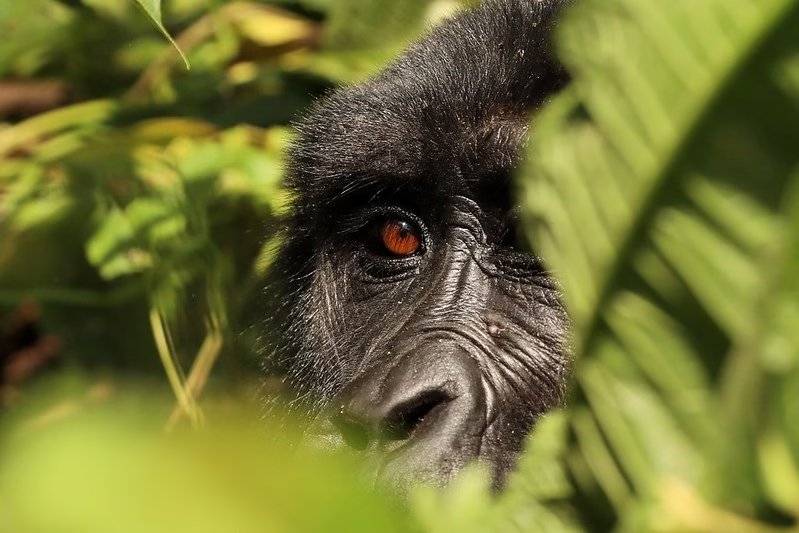
Thanks to Uganda Wildlife Authority, a body in charge of the well-being of all Uganda national parks, Bwindi forest national park sectors including Buhoma, Ruhija, Rushaga, and Nkuringo have been specifically customized to provide all the gorilla tracking fans the greatest tracking experience.
Other wildlife found in Bwindi Forest National Park.
It seems that the presence of mountain gorillas in Bwindi impenetrable national park dominates the awareness of other species in the forest. The extensive bio-network provided by the jungles of Bwindi enables the flourishing presence of numerous species including some whose discoveries are yet to be discovered. Among the animals found in Bwindi forest park are forest elephants, jackals, monkeys (red tails, colobus, vervet, lhoests etc), baboons, forest duikers, Chimpanzees, many bird species and insects.
bwindi forest national park – additional animals and bird species
Access the Bwindi impenetrable national park.
One may practically reach Bwindi forest national park from any area of Uganda and northern Rwanda. From Kampala, the capital of Uganda, it takes around 8 t0 9 hours by car reach Bwindi via Masaka highway to Mbarara, then Kabale and finally Kisoro and Kanungu. But this driving duration depends on the gorilla tracking area of Bwindi forest park, which one would want to visit.
Accessible from Rwanda (Kigali), Bwindi impenetrable national park takes up to four hours to reach, a time range also dependant on the region one is traveling towards. By air, one may also reach Bwindi Park from Entebbe via the several air fields around it, including Kihihi airstrip catering both Buhoma and Ruhiija gorilla tracking area.
Another air strip accessible from Kisoro with serving Rushaga gorilla tracking sector and Nkuringo and other tourism destination to highlight mgahinga national park remaining within Bwindi. The most recent addition to the route came from an air Kenya connecting flight from Masai Mara National Reserve to Bwindi Forest National Park.
One of the most amazing, exciting and intriguing activities carried out at the Bwindi impenetrable national park, the latest addition aims to close a gap between visitors who want to explore the natural richness of masai mara as well dig into gorilla trekking.
Bwindi Impenetrable National Park has how many gorillas?
Before we go into context, let’s raise two questions: “Did you know that half of the worlds’ mountain gorillas live in Bwindi national park?” And “did you know that mountain gorillas are an endangered species”? With the aforementioned issues, we will be able to understand why Bwindi is such a valuable environment and under protection of jealously.
Only 4 gorilla population surveys have been carried out in Bwindi impenetrable national park ever since it was established as a national park in 1991. The first census was carried out in 1994 with 300 as the revealed count; another in 2002 indicating an increment of up to 320; the third census was conducted in 2006 and the samples are still under analysis to determine the number.
Half of the mountain gorillas in the world live in Bwindi Forest National Park, helping to keep you current. If you may ask, where else in Bwindi, where the half of the mountain gorilla population resides, are rest? Well the remainder of the half are spread across parks of Volcanoes Rwanda, Park, Virunga park Congo, and Mgahinga gorilla park Uganda accordingly in Rwanda, Congo and Uganda. The recognized large Virunga region’s area of dispersion.
Tracking gorillas in Bwindi impenetrable national park.
Procedures have been developed for gorilla trekking in Bwindi and other national parks engaged in tracking of gorillas. One of course must obtain a gorilla tracking permission granted by an official in Uganda depending on the gorilla tracking sector you wish to monitor from. The nationality and living situation affect the cost of the permits.
The present Trekking rates are 600usds for foreign non-residents, 500usds for each foreign resident, and ugx250,000 for east African citizens. Note that the mentioned prices relate to June 1, 2019. Foreign non residents will pay 700usds and foreign residents 600usds per permit starting in June 2020. The permits are tied to specific gorilla trekking areas, and the tracking dates follow exactly those stated on the permits.
One of course has to obtain them personally after she has the required permissions to visit the national park. It is also advisable to seek for the services of reputable tour operator who will spare you the hassle of the whole process but rather get you to the tracking and return you your destination successfully. When you arrive at the park on the day of tracking, you must be instructed on gorilla trekking dos and avoid policies from the park headquarters.
Along with the hikers, later rangers are given gorilla families to track from. Later leap into action and explore the forests in pursuit of the softly giant, a search limited to a stop when the gorillas came upon. Finding the Bwindi gorillas takes around thirty minutes to five hours; once you find them, you only have one hour to engage with them. The interactions with the gorillas will teach one about their way of life—feeding, nesting, and family activities. Only photographs and videos will allow one to say the tracking is complete.
For what duration is gorilla trekking in the national park of Bwindi forest?
Any time between 20 minutes from to 3/4 of the whole day, gorilla trekking in Bwindi impenetrable national park might take. The location of the gorilla family you have been a ced to track from determines where the gorilla moves; so, the Gorilla tracking time frame varies based on several elements. The way the trekkers travel will also determine the speed of the group; some may be slow while others might be fit enough to traverse the jungles in pursuit of the gorillas.
Cost of a gorilla hike in Uganda.
Activities at Bwindi Impenetrable National park Uganda/Bwindi Forest National park as well as Mgahinga National park include gorilla treking.
Keep in mind that the gorilla permit for Gorilla Trekking in Uganda costs 600 USD while weighing the expenses. It used to cost 450 USD during the low season in earlier years; but, the cheaper permits vanished some time ago. Only eight persons are permitted to daily walk the 13 gorilla habituated groups that call the mountain home. Three months before trip, book your gorilla permit.
What is a Gorilla Permit?
Describe a gorilla permit. How much does a gorilla permit cost? Get a gorilla permit, please? How am gorilla permits booked? Seeing a mountain gorilla costs how much? Permission for a gorilla is what? These are the most often asked questions by visitors wishing to explore Uganda for a gorilla safari trip.
In what sense is a gorilla permit?
An essential document or card, a gorilla permit lets any visitor engaging in gorilla trekking in Uganda or even gorilla habituation experience there come across the mountain gorillas in their natural environment. Any visitor needs have a valid gorilla trekking permission and gorilla habituation permit so as to enjoy experiences related to both respectively.
A gorilla permit is:
“A gorilla permit: what is it?By far one of the most often asked questions regarding gorilla permits in Uganda is “”. A gorilla permit is what is it? A gorilla permit is a card or paperwork given by the Uganda Wildlife Authority to those wishing go gorilla trekking or habituation in Uganda. A gate ticket of sorts, the gorilla permit lets you enter the natural habitat of the gorillas. Mountain gorillas are found in Mgahinga Gorilla National Park and Bwindi Impenetrable National Park in southern western Uganda.
Seeing a mountain gorilla costs how much? / For what price is a gorilla permit?
Knowing the cost of a gorilla permit can help you to budget your Uganda safari. Though the Uganda permit fees vary every three to four years, the current pricing of a single gorilla trekking permit is $800 for foreign non-residents, $700 for foreign residents and ugx300000 for East African citizens, per person. But a gorilla habituation permit is $1500 per person for one-time use. Uganda Revenue Authority (UWA), the regulating and controlling authority, sets the Uganda permit fee or cost.
Included in a gorilla permit is what?
Most times while visiting any national park in Uganda, one must pay Bwindi Forest National Park admission fees in order to enter the park. When one buys a gorilla permit in Uganda, one does not pay entrance fees as the permit price already covers these costs.
You will therefore not pay Mgahinga Gorilla National Park admission fees or even Bwindi Impenetrable National Park entrance costs. In addition to covering your one hour visit with the mountain gorillas in their natural environment, a gorilla permit ticket also covers the ranger expenses. The gorilla permit also addresses the security you are guaranteed of when visiting Uganda’s gorilla parks.
What is a permit for a gorilla?
Permission for Gorillas
Under a gorilla permit, what is excluded?
One must get a gorilla permit in order to be able to see the Bwindi Forest National Park Uganda gorillas as well as gorillas in Mgahinga Gorilla National Park. Although of course one day Bwindi gorilla safaris are quite achievable especially if you are flying to Bwindi Impenetrable National Park, or enjoying a Bwindi gorilla safari from Kigali, travelers should be aware that gorilla trekking and habituation may be multiple day activities. Travelers must thus cope with lodging, transportation, food, and occasionally even travel insurance—all of which are not accounted for on your Uganda gorilla permits.
One may book a gorilla permit when? /How do I arrange a gorilla permit?
Since gorilla safaris are highly sought after by many people wishing to meet our cousins, who actually share up to 98% DNA with humans, gorilla permits must be booked at least three months in advance before your travel date.
Book your gorilla permit early enough to be able to see the gorillas on your chosen dates and in the Bwindi gorilla sector of your choice for those who would choose gorilla trekking in Bwindi Impenetrable National Park over Mgahinga Gorilla National Park. This guarantees your gorilla safari. You might be asking how I arrange a gorilla permit. Either online or better still, you book your gorilla permit from the Uganda Wildlife Authority headquarters in Kampala via a reputable tour operator on ground to handle your behalf.
What is a permit for a gorilla? And any visitor intending to see the gorillas in Uganda should rightfully ask all other gorilla permit often asked questions. A gorilla permit is a card or certificate allowing entry to enjoy gorilla trekking in Uganda. You have to reserve a gorilla permit even before you choose where to stay. For a great and stress-free gorilla safari, work with a respected travel agent.
How Long Does Trekking Among Gorillas Take?
Mgahinga National Park in Uganda, Virunga National Park in Democratic Republic of Congo, Volcanoes National Park in Rwanda, and the rainforest of Bwindi Impenetrable National Park, (Bwindi forest national park) home Mountain Gorillas.
Visitors can participate in gorilla trekking, a chance to follow untamed forest paths. There are just three nations in Africa where gorilla trekking is possible: Rwanda, Uganda, Democratic Republic of Congo; Uganda Bwindi forest national park has maximum traffic.
arranging Gorilla Trekking
Booking Gorilla Trekking; Mountain Gorillas live in three national parks spread throughout Africa. The most significant national parks where gorilla trekking occurs are Mgahinga in gorilla national park both in Uganda and Bwindi impenetrable national park ( Bwindi forest national park). Others include national parks in DR. Congo Virunga Congo and Volcanoes Rwanda.
Booking Gorilla Trekking means one must obtain a gorilla permit, a card provided to allow admission to the jungle for Gorilla Trekkers. Depending on where they last fed and how swift the trekkers are, the 30-minute and 7-hour journey meets the threatened species. One hour allows you to observe the mountain Gorillas in play, eat, groom one another, and many more.
gorilla permit preservation
One of the most successfully conserved species, the mountain Gorillas numbered 370 individuals in the early 2000s. But according to the 2018 census, the gorillas have since grown to 900 species living in the region.
For sectors, Bwindi Forest national park (Bwindi impenetrable national park) contains Ruhija, Rushaga, Nkuringo and Buhoma. Every industry has family members; the silverback male is the group leader with several ladies and off springs.
The park is a rain forest including nettles and thistles in the bamboo growing fresh shoots.
Beginning between the ages of 9 and 12, gorillas give birth; their gestation cycle is nine months; the infant is weaned between the ages of three and four years. The males will develop the silver back as they grow away from the family to establish new Gorilla families around the age of twelve; when the silverback is old, it protects its family.
Uganda maintains two populations: Bwindi Impenetrable National Park and Virunga Volcanoes.
Uganda’s boundaries, DRC’s, Rwanda’s borders form part of volcanoes.
Beginning in the 1970s and 1980s, mountain gorilla conservation and research projects in the Virunga, Volcanoes in DRC and Rwanda started in 1970s and 1980s
Discovered in 1980s, Bwindi Impenetrable Forest National Park was not only a refuge for the mountain Gorillas but also other rare and endangered species. Taking this into account, Bwindi was declared a park in 1991.
Riding Safaris
Travelers riding bicycles instead of tour automobiles or walking excursions is the fascinating experience known as biking safaris. For its visitors, Bwindi impenetrable forest national park provides riding safaris.
As you enjoy a community bike ride, bwindi riding safaris across the park offers the visitor an incredible perspective of the park. On the journey, you also have opportunity to see many bird species, animals, butterflies, primates all around.
Sometimes the Organization under the Ride 4 a Woman moniker supplies the bikes.
Discover the forest while riding the mountain bike; you may ride a day with a knowledgeable guide; it’s rather enjoyable with a guide and you won’t miss anything on the trip.
One of the reasons most tourists remain behind for another day for a mountain bike is the guide is highly versed and trained in wildlife species, plant species, birds, trees of Bwindi Impenetrable Forest half-day or full day on a bike.
Where is to lodge?
For its guests, Bwindi national park offers a large range of luxurious and reasonably priced lodging options. Make sure you visit the lodging to be able to choose your best one. Among the lodging options provided both inside and outside of Bwindi Forest National Park, some fall in budget, mid-range, luxury category.
hotels
A few of the lodging facilities surrounding Bwindi Impenetrable Forest National Park
Reserve a Gorilla Permit.
An identifier indicating that a visitor has been allowed either for gorilla habituation or for trekking the gorillas is a gorilla permit. Less expensive than gorilla habituation permit is gorilla hiking permit. Make sure you select the correct Tour Operator to assist with advance gorilla permit booking.
Which safaris company ought one to choose?
Make sure you travel with Maseke Adventure Co. Ltd, as they provide a broad spectrum of activities fit for you. They direct your trip exactly and supply you with appropriate means of mobility.

